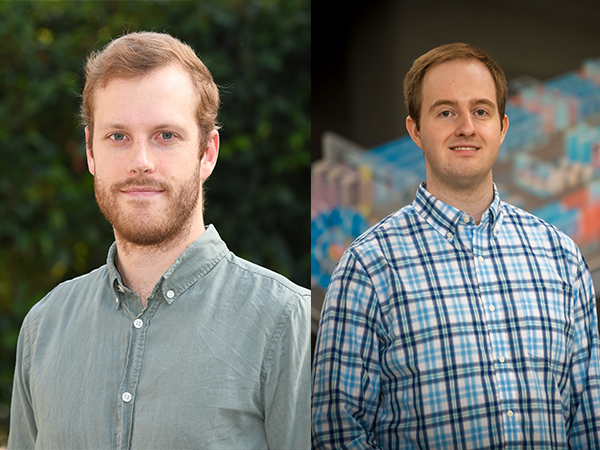
Sutcliffe (left) was selected for a fellowship to conduct research at Lawrence Livermore National Laboratory (LLNL) in California; Adrian (right) was chosen to receive a fellowship from Los Alamos National Laboratory (LANL) in New Mexico.
Images provided courtesy of Graeme Sutcliffe and Patrick Adrian.
July 27, 2023
Two MIT graduate students, Patrick Adrian and Graeme Sutcliffe, have been awarded distinguished fellowships to further their studies of high-energy-density physics. Adrian was chosen to receive the Director’s Postdoctoral Fellowship in High-Energy-Density Sciences (HEDS) from Los Alamos National Laboratory (LANL) in New Mexico; Postdoctoral Associate Graeme Sutcliffe was selected for the HEDS Postdoctoral Fellowship to conduct research at Lawrence Livermore National Laboratory (LLNL) in California.
Adrian, a Nuclear Science and Engineering student at MIT working in the High-Energy-Density-Physics Division (HEDP) at MIT's Plasma Science and Fusion Center, is scheduled to defend his PhD thesis, “Studying particle and energy transport using nuclear and x-ray diagnostics for discovery science and Inertial Confinement Fusion (ICF)” in October of this year.
“The results from Adrian’s work studying particle and energy transport in ICF plasmas will have important implications for the ignition experiments at the National Ignition Facility,” says HEDP Division Head Johan Frenje.
Adrian was selected for the Director’s Fellowship at LANL based on his academic performance and research accomplishments, as well as the strength of his proposed research, which he colloquially explained as creating “little stars in the lab.” Just as real stars consist of fusion-powered burning plasma, Adrian’s “stars” produce plasma and charged particles, the movements and longevity of which can be measured using “stopping-power” experiments to better understand how plasmas degenerate in fusion reactions. He will use LANL's xRAGE code to design a stopping-power experiment that can produce degenerate plasmas, and validate his experimental modeling at OMEGA Laser Facility.
Sutcliffe worked in the HEDP Division under the supervision of Senior Research Scientist Chikang Li. In September 2022, Sutcliffe defended his PhD thesis titled, “Experimental Studies of Magnetic Field Generation and Saturation Mechanisms in Laser-driven Plasmas.” Chikang Li said of his work, “Graeme’s thesis covers a remarkable range of accomplishments in the areas of diagnostics development, execution of experiments, data analysis, and numerical simulations, generating novel physical insights on the saturation mechanisms and dynamics of self-generated magnetic field in laser-driven plasmas.”
The HEDS Fellowship is typically only awarded to one outstanding individual each year, and Sutcliffe was selected thanks to his excellent scientific track record and potential for significant achievements. As a HEDS Fellow, Sutcliffe is free to pursue his own research under the guidance of a senior staff scientist at LLNL. His plan is to continue studying magnetic field generation in plasmas, and in particular, the dynamics of merging Weibel-instability filaments, which are central to understanding large-scale magnetic fields observed in galaxies. This technique allows researchers to use highly configurable lasers to create wind tunnel-like test platform in which they can create lab-sized plasmas that behave like astrophysical plasmas. He will pair his study of Weibel instabilities with research on the magnetic fields generated by lasers used in inertial confinement fusion.